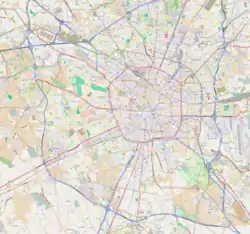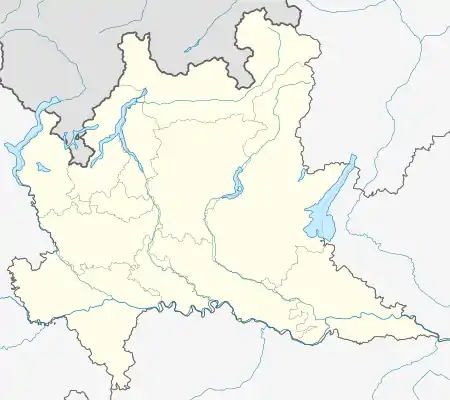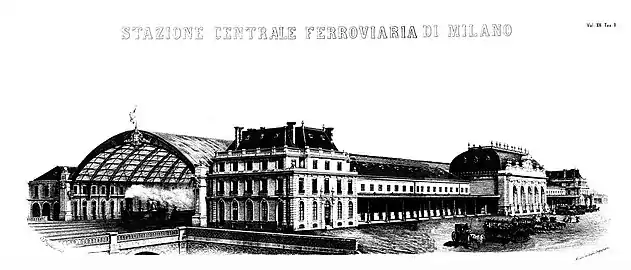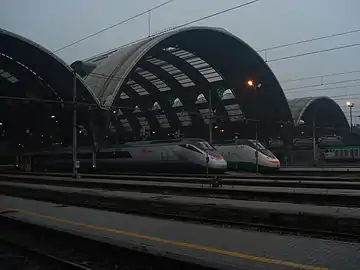Milano Centrale railway station
Milano Centrale (Italian: Stazione Milano Centrale) is the main railway station of the city of Milan, Italy, and is the largest railway station in Europe by volume. The station is a terminus and located at the northern end of central Milan. It was officially inaugurated in 1931 to replace the old central station (built 1864), which was a transit station but with a limited number of tracks and space, so could not handle the increased traffic caused by the opening of the Simplon tunnel in 1906.
Milano Centrale | |
|---|---|
 Main entrance portico on Piazza Duca d'Aosta, 2016 | |
| Location | Piazza Duca d'Aosta 20124 Milan Italy |
| Coordinates | 45°29′10″N 09°12′13″E |
| Owned by | Rete Ferroviaria Italiana |
| Operated by | Grandi Stazioni |
| Line(s) | |
| Tracks | 24 |
| Connections |
|
| Construction | |
| Architect | Ulisse Stacchini |
| Other information | |
| IATA code | XIK[1] |
| History | |
| Opened | 1 July 1931 |
| Electrified | 1938 |
| Passengers | |
| 120 million per year | |
| Location | |
 Milano Centrale Location in Milan  Milano Centrale Location in Lombardy  Milano Centrale Location in Northern Italy  Milano Centrale Location in Italy | |
Milano Centrale has high-speed connections to Turin in the west, Venice via Verona in the east and on the north-south mainline to Bologna, Rome, Naples and Salerno. The Simplon and Gotthard railway lines connect Milano Centrale to Bern and Geneva via Domodossola and Zürich via Chiasso in Switzerland.
Destinations of inter-city and regional railways radiate from Milano Centrale to Ventimiglia (border of France), Genova, Turin, Domodossola (border of Swiss Canton of Valais/Wallis), Tirano (border of Swiss Canton of Graubünden/Grisons), Bergamo, Verona, Mantova, Bologna and La Spezia.
The Milan suburban railway service, however, does not use Milano Centrale but the other mainline stations: Porta Garibaldi (northwest), Cadorna (west) and Rogoredo (east).
Aldo Rossi declared in an interview of February 1995 to Cecilia Bolognesi:[2] "They told me that when Frank Lloyd Wright came to Milan, and he came only once, he was really impressed by it and said it was the most beautiful station in the world. For me it is also more beautiful than Grand Central Station in New York. I know few stations like this one".
History
The first Milano Centrale station opened in 1864 in the area now occupied by the Piazza della Repubblica, south of the modern station.[3] It was designed by French architect Louis-Jules Bouchot[4] (1817–1907) and its architectural style was reminiscent of Parisian buildings of that period. The station was designed to replace Porta Tosa station (opened in 1846 as the terminus of the line to Treviglio and eventually Venice) and Porta Nuova station (opened in 1850 as the second terminus on the line to Monza, which was eventually extended to Chiasso) and was interconnected with all lines, either existing or under construction, surrounding Milan. It remained in operation until 30 June 1931, when the current station was opened. There is now no trace of the old station left.
King Victor Emmanuel III of Italy laid the cornerstone of the new station on April 28, 1906, before a blueprint for the station had even been chosen. The last, real, contest for its construction was won in 1912 by architect Ulisse Stacchini, whose design was modeled after Washington Union Station in Washington, DC,[5] and the construction of the new station began. The purported style was an eclectic mix called "Assyrian-Lombard."[6]
Due to the Italian economic crisis during World War I, construction proceeded very slowly, and the project, rather simple at the beginning, kept changing and became more and more complex and majestic. This happened especially when Benito Mussolini became Prime Minister, and wanted the station to represent the power of the Fascist regime.[7] The major changes were the new platform types and the introduction of the great steel canopies by Alberto Fava; 341 m (1,119 ft) long and covering an area of 66,500 square metres (716,000 sq ft).
Construction resumed in 1925 and on July 1, 1931, the station was officially opened in the presence of Foreign Minister Galeazzo Ciano.[8]
The station played a vital role during the Holocaust in Italy, when Jewish inmates from the San Vittore Prison, previously captured in northern Italy, would be taken to a secret track, Binario 21, underneath the station to be deported to extermination camps. Altogether, 15 deportation trains with 1,200 prisoners left the station from Binario 21. A Memoriale della Shoah was opened at the former platform in January 2013 to commemorate these events.[9][10]
Its façade is 200 metres (660 ft) wide and its vault is 72 metres (236 ft) high, a record when it was built. It has 24 platforms. Each day about 330,000 passengers use the station, totaling about 120 million per year.
The station has no definite architectural style, but is a blend of many different styles, especially Liberty and Art Deco, but not limited to those. It is adorned with numerous sculptures. "The 'incongruous envelope of stone' (Attilio Pracchi) of this gigantic and monumental building dominates Piazza Duca d'Aosta."[11]
On September 25, 2006, officials announced a €100 million project, already in progress, to refurbish the station. Of the total cost, €20 million has been allocated to restore "certain areas of high artistic value" while the remaining €80 million will be used for more general improvements to the station to make it more functional with the current railway services. The project includes moving the ticket office and installing new elevators and escalators for increased accessibility.[12]
There remain unrestored and inaccessible areas to the public within the station, including a waiting room with swastikas on the floor designed to receive Hitler.[6]
Gallery
 The first Milano Centrale railway station from Giornale dell'Ingegnere e Architetto, January 1865, vol. 13, Annex
The first Milano Centrale railway station from Giornale dell'Ingegnere e Architetto, January 1865, vol. 13, Annex A view of the arrival hall
A view of the arrival hall The roof of the central section
The roof of the central section_-_BEIC_6330877.jpg.webp) Lateral view of the gallery
Lateral view of the gallery
Train services
The station has 24 tracks. Every day about 320,000 passengers pass through the station using about 500 trains, for an annual total of 120 million passengers. The station is served by national and international routes, with both long-distance and regional lines. Daily international destinations include Bern, Lugano, Geneva, Zürich, Paris, Vienna, Marseille and Munich.[13] The station is also connected to Milan-Malpensa Airport through the Malpensa Express airport train.
The following services call at the station (incomplete):
Domestic (High-speed)
- High-speed train (Trenitalia Frecciarossa) Turin-Salerno: Turin Porta Nuova - Turin Porta Susa - Milano Centrale - Milan Rogoredo - Bologna Centrale - Florence S.M.Novella - Rome Tiburtina - Rome Termini - Naples Centrale - Salerno
- High speed train (Trenitalia Frecciarossa) Milan-Bari: Milan - Bologna - Ancona - Pescara - Foggia – Bari
- High-speed train (Trenitalia Frecciarossa) Milan-Venice: Milan - Brescia - Peschiera del Garda - Verona - Vicenza - Padua - Venice
- High-speed train (Italo NTV) Turin-Salerno: Turin - Milan - Bologna - Florence - Rome - Naples - Salerno
- High-speed train (Trenitalia Frecciabianca) Turin-Venice: Turin - Novara - Milan - Brescia - Verona - Vicenza - Padua - Venice - (Trieste)
- High-speed train (Trenitalia Frecciabianca) Milan-Lecce: Milan - Piacenza - Parma - Reggio d'Emilia - Modena - Bologna - Rimini - Pesaro - Ancona - San Benedetto del Tronto - Pescara - Termoli - Foggia - Bari - Brindisi - Lecce
- High-speed train (Trenitalia Frecciabianca) Milan-Bari/Taranto: Milan - Modena - Bologna - Rimini - Ancona - Pescara - Foggia - Bari - Taranto
Domestic
For regional (Regio) trains to Monza and Como from Milano Centrale, refer to the 'cross-border' services. There is no train service of Milan Suburbano at the Centrale station.
- Airport train (Trenord Malpensa Express) Milan-Malpensa Airport: Milan - (Busto Arsizio) - Malpensa Airport
- Intercity train (Trenitalia Intercity) Milan-Lecce: Milan - Piacenza - Parma - Modena - Bologna - Rimini - Ancona - Pescara - Foggia - Trani - Bari - Fasano - Brindisi - Lecce
- Intercity train (Trenitalia Intercity) Milan-Taranto: Milan - Lodi - Piacenza - Parma - Reggio Emilia - Modena - Bologna - Faenza - Cesena - Rimini - Riccione - Pesaro - Senigalla - Ancona - Giulianova - Pescara - Termoli - Foggia - Trani - Bisceglie - Bari - Taranto
- Intercity train (Trenitalia Intercity) Milan-Livorno: Milan - Pavia - Tortona - Genova Piazza Principe - Genova Brignole - Santa Margherita Ligure-Portofino - Rapallo - Chiavari - Sestri Levante - Levanto - Monterosso - La Spezia Centrale - Massa Centro - Viareggio - Pisa Centrale - Livorno Centrale
- Intercity train (Trenitalia Intercity) Milan-Ventimiglia: Milan - Pavia - Genova - San Remo - Ventimiglia
- Night train (Trenitalia Intercity Notte) Milan-Lecce: Milan - Piacenza - Parma - Reggio d'Emilia - Modena - Bologna - Cesana - Rimini - Ancona - Pescara - Foggia - Bari - Trani - Brindisi - Lecce
- Regional train (Trenitalia Regionale Veloce) Turin-Milan: Turin - Vercelli - Novara - Milan
- Regional train (Trenitalia Regional) Milan-Alessandria: Milan - Pavia - Voghera - Tortona - Alessandria
- Regional train (Trenord Regio) Milan-Verona: Milan - Brescia - Peschiera del Garda - Verona
- Regional train (Trenord Regio) Milan-Tirano: Milan - Lecco - Sondrio - Tirano
- Regional train (Trenord Regio) Milan-Mantua: Milan - Lodi - Codgono - Cremona - Piadana - Mantova
- Regional train (Trenord Regio) Milan-Bergamo: Milan - Treviglio - Bergamo
- Historic train (Fondazione FS/Trenitalia Storico) Milan-Varallo: Milan - Novara - Varallo Sesia
Cross-border (Night train)
(CH for Switzerland, D for Germany, A for Austria, MN for Monaco)
The following train has been moved to stop at Milano Lambrate railway station and Milano Porta Garibaldi railway station in 2020:
- Night train (ÖBB Nightjet) Milan-Munich/Vienna: Milan - Brescia - Peschiera del Garda - Verona^ - (Rovereto/Rofreit) - (Trento/Trient) - Bolzano/Bozen - (Brennero/Brenner) - Innsbruck (A) - Jenbach (A) - Kufstein (A) - Munich (D)
This train connects at Verona with ÖBB Nightjet/EuroNight Rome-Vienna: the train splits into two parts (first half couples with ÖBB Rome-Vienna and leaves for Vienna or Rome; second half continues to Munich or Milan). Vienna-Rome splits into two trains (first half continues to Rome or Vienna; second half couples with the train for Milan or Munich).
Cross-border
After the opening of Gotthard Base Tunnel in December 2016, train services between Milan and Switzerland increased in frequency. All SBB-CFF-FSS Eurocity now save 35 minutes of total journey time between Bellinzona and Arth-Goldau.
From December 2017, a new cross-border service Milan-Frankfurt (DB-SBB Eurocity) via Zürich will be operational.
- Regional train (TiLo Regio) Milan-Bellinzona: Milan - Monza - Como (San Giovanni) - Chiasso (CH) - Lugano (CH) - Bellinzona (CH)
- Intercity train (SBB-CFF-FSS EuroCity) Geneva-Milan/Venice: Geneva/Genf (CH) - Lausanne (CH) - Brig (CH) - Domodossola - Milan - (Brescia) - (Verona) - (Padua) - (Venice)
- Intercity train (SBB-CFF-FSS EuroCity) Basel-Milan: Basel SBB (CH) - Bern/Berne (CH) - Thun (CH) - Brig (CH) - Domodossola - Stresa - Busto Arsizio - Milan
- Intercity train (SBB-CFF-FSS EuroCity) Zürich-Milan: Zürich (CH) - Zug (CH) - Arth-Goldau (CH) - Bellinzona (CH) - Lugano (CH) - Chiasso (CH) - Como (San Giovanni) - Monza - Milan
- Intercity train (SBB-CFF-FSS EuroCity) Luzern-Milan: Luzern (CH) - Arth-Goldau (CH) - Bellinzona (CH) - Lugano (CH) - Chiasso (CH) - Como (San Giovanni) - Monza - Milan
- Intercity train (Thello EuroCity) Milan-Marseilles: Milan - Genoa - San Remo - Menton (F) - Monaco Monte Carlo (MN) - Nice (F)
| Preceding station | Trenitalia | Following station | ||
|---|---|---|---|---|
toward Torino Porta Nuova | Frecciarossa | toward Salerno |
||
| Terminus | toward Bari Centrale |
|||
toward Turin Porta Nuova | Frecciabianca | toward Trieste Centrale |
||
| Terminus | toward Udine |
|||
toward Lecce |
||||
toward Taranto |
||||
toward Basel SBB | EuroCity | Terminus | ||
toward Geneva Cornavin | toward Venice Santa Lucia |
|||
toward Nice-Ville | Thello | Terminus | ||
| Terminus | Intercity Notte | toward Lecce |
||
toward Lecce |
||||
toward Torino Porta Nuova | Treno regionale | Terminus | ||
| Nuovo Trasporto Viaggiatori | ||||
toward Torino Porta Nuova | Italo | toward Salerno |
||
| Trenord | ||||
| Treno regionale | Terminus | |||
| Terminus | toward Verona Porta Nuova |
|||
toward Bergamo |
||||
Platforms
| ||||||||||||||||||||||||||||||||||||||||||||||||||||||||||||||||||||||||||||||||||||||||||||||||||
The station, along with Roma Termini and Firenze Santa Maria Novella, has security gates which prevent access to the platforms without a ticket.
Each platform is usually dedicated to some particular route. The current organization is as follows, although temporary changes may occur.
- Platforms 1-3: Chiasso/Domodossola/Milan-Turin (ES* AV)
- Platforms 4-6: Turin/Cisalpino Milan–Como–Arth Goldau–Basel / Zürich
- Platforms 7-13: Venice / Udine
- Platforms 14-17: Bologna–Florence–Rome–Naples
- Platforms 18-23: Genoa-Livorno / Ventimiglia / Parma /Cremona-Mantua /Milan-Treviglio-Bergamo
- Platform 24: Operations
Unusual track layout
On the northern side of the railway yard there used to be a loop curve so that trains could turn around and reverse back into the station. The trains could so be displaced from the left side of the station to the right side and vice versa without crossing all the tracks. The tracks on the loop curve are partially broken up.[14]
Images
See also
References
- "Airport codes Milano (Milan), Italy (IT) | ICAO, IATA codes, location of airports of Airport codes Milano (Milan), Italy (IT) | latitude, longitude airports of Airport codes Milano (Milan), Italy (IT) | coordinates of airports of Airport codes Milano (Milan), Italy (IT) | International codes and coordinates of all airports in the world | International codes and coordinates of all airports in Airport codes Milano (Milan), Italy (IT)". airportsbase.org. Retrieved 29 April 2019.
- Aldo Rossi, Luoghi Urbani, Unicopli 1999, p. 31
- see also Milano Repubblica railway station
- Maulsby, Lucy M. (January 2014). Fascism, Architecture, and the Claiming of Modern Milan, 1922 1943. ISBN 9781442646254.
- "Design". RETOURS. Retrieved 2 August 2018.
- Daverio, Philippe. Lombardy. Milan: RCS Libri, 2015. p 47.
- "Bombastic Sculptures". RETOURS. Retrieved 2 August 2018.
- The New Central Station at Milan Railway Gazette 11 September 1931 pages 331-341
- "Mailand" (in German). Gedenkorte Europa 1939–1945. Retrieved 11 September 2018.
- Bridget Kevane (29 June 2011). "A Wall of Indifference: Italy's Shoah Memorial". The Jewish Daily Forward.com. Retrieved 3 October 2018.
- Touring Club Guida di Milano, p. 471
- "100mln Euros to requalify Milan Railway Central Station". AGI. 2006-09-25. Archived from the original on January 5, 2007. Retrieved 2006-09-28.
- "International Destinations". Ferrovie dello Stato. Archived from the original on 11 January 2015. Retrieved 20 September 2011.
- Can easily be seen on Google Earth and most old maps
External links
| Wikimedia Commons has media related to Milano Centrale train station. |
- Official website at Grandistazioni website
- Winchester, Clarence, ed. (1936), "Milan Central station", Railway Wonders of the World, pp. 546–552 Illustrated contemporary description of the station




